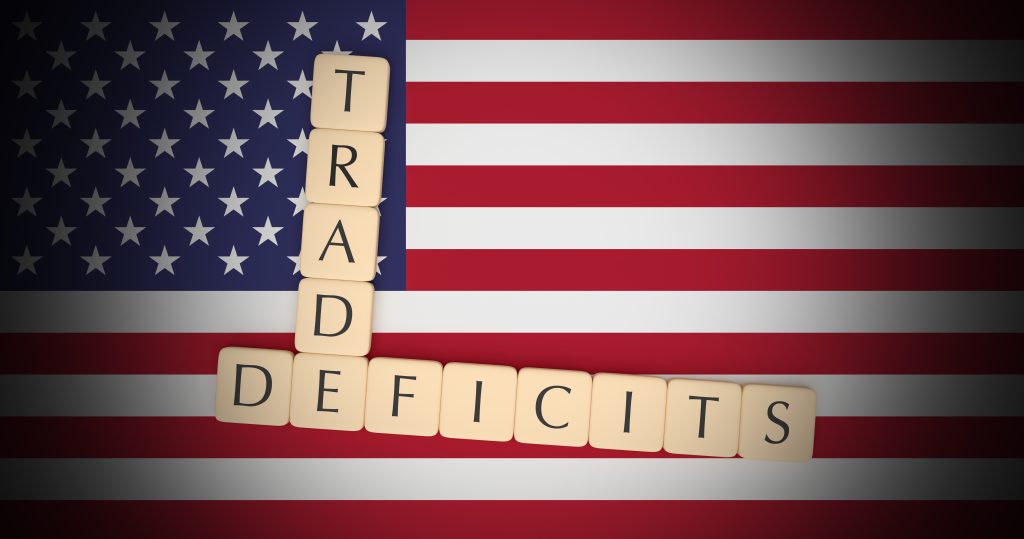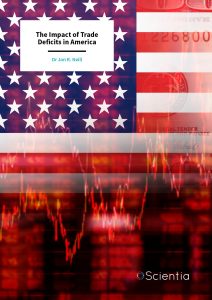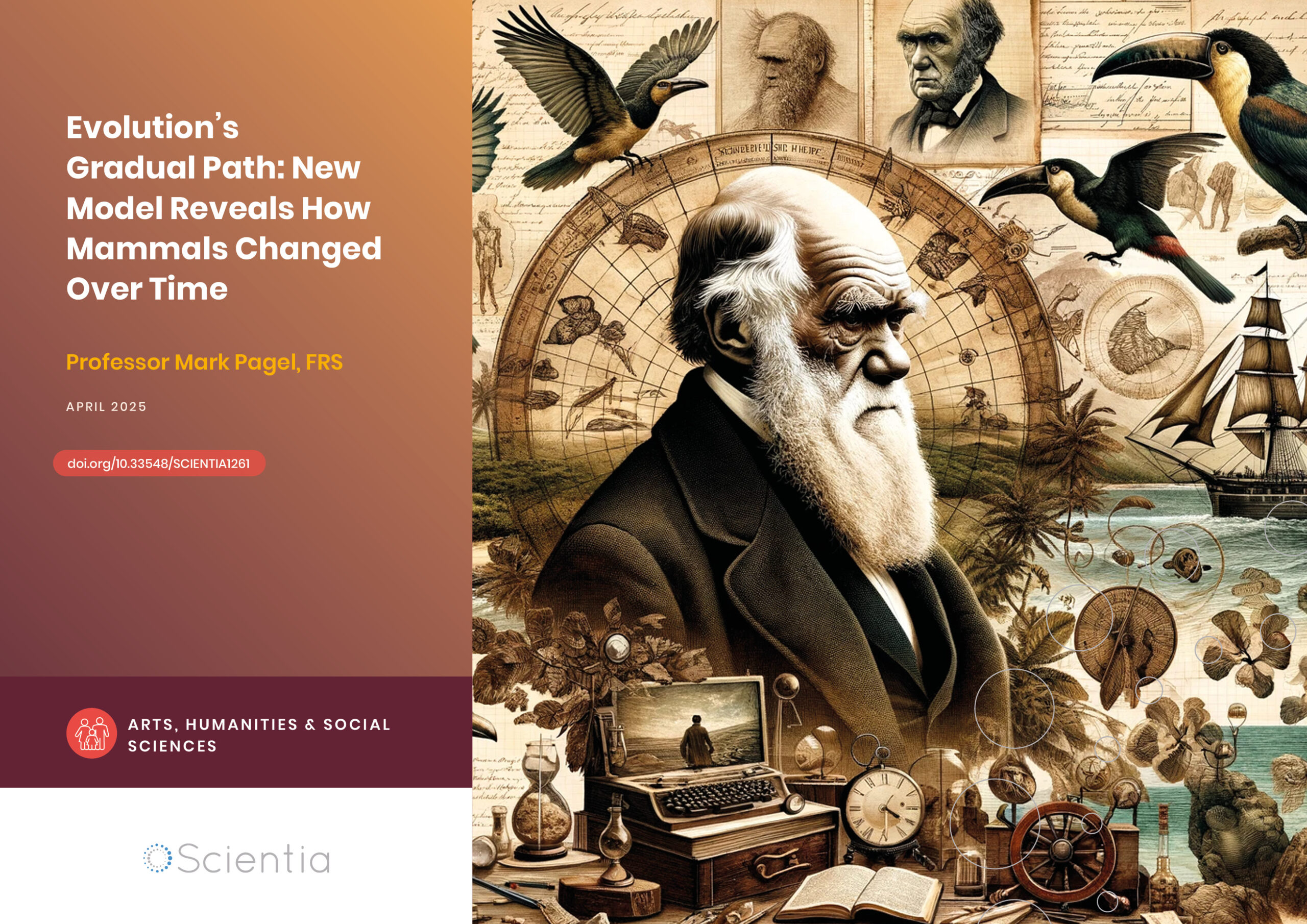Dr Jon Neill | The Impact of Trade Deficits in America
Former President Donald Trump promised to bring jobs back to the U.S., arguing that the trade deficit was responsible for slow economic growth and costing the economy jobs. While the Trump administration popularised the issue, historically, the broad impact of trade deficits has been contentious. Dr Jon Neill is a Professor of Economics at Western Michigan University. His computational modelling has shown that U.S. residents would experience a slight loss if consumer goods currently being imported from countries like China, were produced domestically instead. His calculations question whether the net benefit from trade with low-wage countries is warranted, given the distributional impact of that trade.
Trade Deficits Explained
In simple terms, a trade deficit means a country buys more goods and services than it sells. A trade deficit occurs when a country’s imports (products and services made and purchased from other countries) exceed exports (products and services produced at home and sold to other countries). Objectively, a trade deficit is neither good nor bad, and a proportionate trade deficit can signal a strong and growing economy.
The U.S. ran a trade surplus through the 1960s and 1970s. Since the 1980s, a large trade deficit emerged, which has been sustained to the present day, accelerated by Chinese competition in manufacturing. One of the benefits of U.S. trade with China, India and Mexico, is the lower prices at which goods imported from these countries are sold to American consumers.
Employee wages in these countries are much lower than in the U.S., and this lowers the overall cost of production, allowing foreign firms to undercut the prices of similar goods made in the U.S. Proponents of free trade believe that this generates significant welfare benefits to consumers.
However, one of the common reasons trade deficits can be considered deleterious to an economy is that trade deficits result in job losses. If products produced within the U.S. cannot compete with cheaper international varieties, these firms are forced to downsize or shut down completely, therefore laying off American workers.
The Impact of Trade on Consumer Prices
The current debate over U.S. trade policy has, for the most part, focused on the impact of trade on employment opportunities and wages. Dr Jon Neill, Professor of Economics at Western Michigan University, set out to quantify the consumer surplus that would be lost if manufactured goods currently being imported to the U.S. from lower-wage countries were produced in the U.S. instead.
Consumer surplus is an economic measurement of the benefits derived to the consumer from increases in market competition. In technical terms, a consumer surplus happens when the price that a consumer pays for a product is less than the price they’re willing to pay for it.
In the context of reducing trade deficits, if foreign manufacturers are able to produce at a lower cost than American producers, but are then forced out of U.S. markets through trade restrictions, U.S. firms begin producing the goods that had previously been imported. The elimination of cheaper foreign items lowers the consumer surplus, as the consumer pays larger prices for the same goods.

Estimating Lost Consumer Surplus
Dr Neill quantified the impact of reducing imports of consumer goods by enough to eliminate the trade deficit with major low-wage trading partners, such as China and Mexico. Specifically, he focused on measuring the loss of consumer surplus that would result from eliminating this part of the U.S. trade deficit.
Quantifying this hypothetical loss to consumers was a formidable task, but Dr Neill engaged in ‘mathematical gymnastics’ to solve the problem. The model Dr Neill calibrated used data he retrieved from the U.S. Census Bureau, Bureau of Economic Analysis, and Conference Board. He applied robust mathematical and economic assumptions to his theoretical model and calculations. For example, he assumed that all countries produce consumer goods similarly.
Dr Neill also utilised a computational model that did not rely on specific assumptions regarding consumer preferences and production functions, so that his conclusions would better reflect reality. In terms of further contributions, his model offers the literature a novel way of approaching economic questions regarding the consequences of trade.
The Effects of Limiting Trade on Wages
He concluded eliminating about $600 billion of imported goods – the amount required to eliminate nearly all of the trade deficit with low wage countries – would bring minimal benefit to Americans in real terms. To estimate the overall economic benefit, he explored the benefits of greater job availability and possibly larger salaries.
If consumers find that they cannot buy certain goods from abroad anymore, it will increase the demand for them in the U.S., and American firms will respond by producing more of those goods and hiring more workers in the process. To calculate this increase in the demand for employees, Dr Neill used U.S. shipment data on employment in the automotive products industry for products imported from Japan, Korea and Mexico.
He found that the increase in the demand for employees would increase wages by 0.66%, which amounts to $537, about 70% of the average loss in consumer surplus. He varied his analysis based on the elasticity of the supply of labour. For example, low-income workers tend to have higher elasticities than other workers because they respond more to increased income. He also considered how different sub-markets might change their demand for employees, given that international competition affects American producers differently.
Does Importing Goods from Low-Wage Countries Hurt Americans?
Dr Neill concluded that ‘our estimates offer some evidence that a significant reduction in the importation of consumer goods may not impose a substantial net loss of welfare on U.S. residents’. He found that the increase in demand for workers partially offsets and compensates for the loss to consumers.
In contrast to other researchers, Dr Neill proposed that there would be a net benefit to many workers – potentially four times the average loss of consumer surplus. As such, possibly tens of millions of workers would benefit if certain imported goods were instead produced in the country.
SHARE
DOWNLOAD E-BOOK
REFERENCE
https://doi.org/10.33548/SCIENTIA938
MEET THE RESEARCHER

Dr Jon R. Neill
Department of Economics
Western Michigan University
Kalamazoo, MI
USA
Dr Jon Neill is a Professor of Economics at Western Michigan University. He received a PhD in Economics from the University of Pittsburgh in 1983 with his thesis, ‘Household Willingness to Pay for Unemployment Insurance Entitlement’. Before this, he had completed two Master’s degrees, one in Mathematics and the other in Economics, both at the University of Pittsburgh. In 1980, he was appointed Assistant Professor in the Department of Economics at Western Michigan University, followed by Associate Professor in 1987 and Professor in 2000. His research examines public finance and environmental economics with crossovers in microeconomics and macroeconomics. Dr Neill’s research has been published in the Journal of Public Economics, the Journal of Environmental Economics and Management, the Scandinavian Journal of Economics and other highly respected economics journals.
CONTACT
W: https://wmich.edu/economics/directory/neill
FURTHER READING
D Alexander, J Neill, Inefficient or not, hospitals are still over-charging, International Advances in Economic Research, 27(4), 2022, 273–286. DOI: https://doi.org/10.1007/s11294-022-09840-z
J Neill, If Fed acts wisely, expect inflation rate to regress, Grand Rapids Business, 2022. https://www.crainsgrandrapids.com/uncategorized/if-fed-acts-wisely-expect-inflation-rate-to-regress/
J Neill, Using consumer’s surplus to bound willingness to pay for non-market goods, Resource and Energy Economics, 2022, 101276. DOI: https://doi.org/10.1016/j.reseneeco.2021.101276
J Neill, Comparing Some Benefits and Costs from Eliminating the U.S. Trade Deficit with Low Wage Countries, International Advances in Economic Research, 2021, 27, 91–103. DOI: https://doi.org/10.1007/s11294-021-09823-6

REPUBLISH OUR ARTICLES
We encourage all formats of sharing and republishing of our articles. Whether you want to host on your website, publication or blog, we welcome this. Find out more
Creative Commons Licence (CC BY 4.0)
This work is licensed under a Creative Commons Attribution 4.0 International License. 
What does this mean?
Share: You can copy and redistribute the material in any medium or format
Adapt: You can change, and build upon the material for any purpose, even commercially.
Credit: You must give appropriate credit, provide a link to the license, and indicate if changes were made.
SUBSCRIBE NOW
Follow Us
MORE ARTICLES YOU MAY LIKE
Professor Robert B Heimann | Culinary Craftmanship: The Evolution of Pottery for Cooking
Cooking food is arguably one of the most important transitions in human evolution, and initiated hundreds of thousands of years of refinement in both technique and technology. Professor Emeritus Robert B Heimann of TU Bergakademie Freiberg, Germany, recently reviewed the evidence for early cooking vessels and tracks the evolution of their production, identifying important strategies of optimisation using various natural materials, firing methods, and designs to improve durability, functionality, and efficiency over time.
Professor Mark Pagel | Evolution’s Gradual Path: New Model Reveals How Mammals Changed Over Time
A groundbreaking statistical model developed by Professor Mark Pagel and colleagues at the University of Reading demonstrates that even dramatic evolutionary changes in mammals can be explained through gradual Darwinian processes, resolving a long-standing puzzle in evolutionary biology and challenging our understanding of how species change over time.
Professor Layla Branicki | Building Better Workplaces for Neurodivergent Employees
The landscape of work is undergoing a radical transformation, with flexible arrangements and remote working becoming increasingly embedded in organisational culture. However, for the estimated 15-20% of people who are neurodivergent – including those with Autism Spectrum Disorder (ASD), Attention-Deficit Hyperactivity Disorder (ADHD), dyslexia, and other cognitive differences – navigating the workplace can present unique and sometimes overwhelming challenges. Researchers at the University of Bath have conducted the largest UK study of its kind, exploring how flexible working practices can support neurodivergent employees in the workplace, revealing both challenges and opportunities for creating more inclusive work environments.
The Decline of Volunteering in America: Economic Factors and Rural-Urban Differences
Volunteering rates have been declining across the US in recent decades, raising concerns about the health of civil society and local communities. Researchers Dr Rebecca Nesbit, Dr Laurie Paarlberg, and their colleagues have investigated the complex economic and geographic factors contributing to this trend. Their work sheds light on how economic conditions, rural-urban differences, and community characteristics shape volunteering behaviors across the country.





